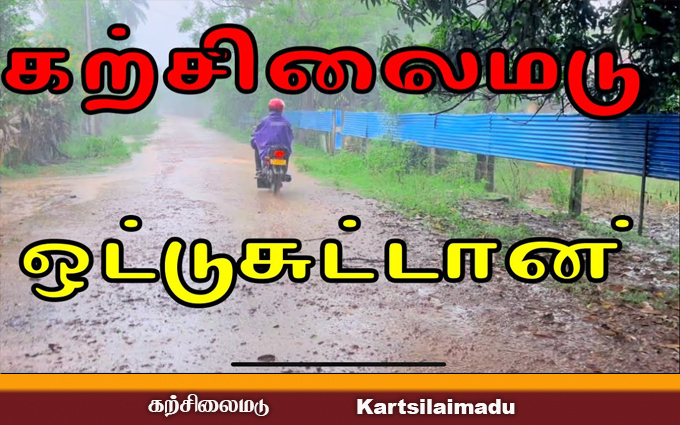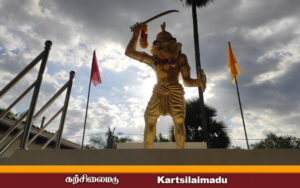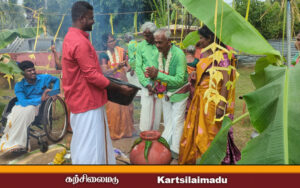

Kartsilaimadu is a village in the currently occupied Tamil Eelam’s Mullaitivu District

Kartsilaimadu is a village in the currently occupied Tamil Eelam’s Mullaitivu District on Ceylon Island, that now falls under Sri Lanka’s Ottisuttan Divisional Secretariat. Kartsilaimadu held a prominent position within Vanni Rasathani, instilling fear in the occupying colonial powers of the Portuguese, Dutch, and British whenever their invading forces were stationed there. The Mullai nilam (Pastoral) landscape and Marutham (Agricultural) areas goes hand in hand, contributing to the fertility and prosperity of the heroic Vanni rasadhani region, symbolized by the towering stone pillar with the obelisk of the hero Pandara Vanniyan, in Kartsilaimadu. As the Eelam Liberation War unfolded, Kartsilaimadu stood for its valor and sacrifice, reflective of the region’s Mullai nilam (Pastoral) and Marutham (Agricultural) bounty. The region’s economic backbone, encompassing farming, air crops, forestry, animal husbandry, and the cultivation of small grains, underscores its prosperity. With its imposing presence, Kartsilaimadu celebrates its essential contribution to the struggle of Eelam, marking the development of numerous celebrated creators, scholars, and educators.
 What is the origin of the name “Kartsilaimadu”? It is widely believed that the origin of “Kartsilaimadu” stems to the fact that it houses Pandara Vanniyan inscription, which is situated within the area, marking its historical significance. While Kathsilaimadu was a key stronghold for Pandara Vanniyan, however, it would seem the name ‘Kartsilaimadu’ is not linked to the inscription documenting Pandara Vanniyan’s defeat. J.P. Lewis highlighted that although Pandara Vanniyan faced defeat at the hands of Captain Von Rieback in 1803 at Kartsilaimadu, the precise site of this pivotal battle remained unidentified until nearly a century later, by R. A. G. Wesring, Mullaitivu’s Vice Chancellor, in 1904-1905. Erecting a stone to mark this event served not just to remember Pandara Vanniyan’s defeat but also acted as a stark reminder of the occupying forces’ need to cement their victory on the land and its people. The naming and significance of Kartsilaimadu, recognized as the finest village in the pattu, were documented in “A Manual of Vanni Districts” in 1895, predating the foundation stone’s placement in 1904.
What is the origin of the name “Kartsilaimadu”? It is widely believed that the origin of “Kartsilaimadu” stems to the fact that it houses Pandara Vanniyan inscription, which is situated within the area, marking its historical significance. While Kathsilaimadu was a key stronghold for Pandara Vanniyan, however, it would seem the name ‘Kartsilaimadu’ is not linked to the inscription documenting Pandara Vanniyan’s defeat. J.P. Lewis highlighted that although Pandara Vanniyan faced defeat at the hands of Captain Von Rieback in 1803 at Kartsilaimadu, the precise site of this pivotal battle remained unidentified until nearly a century later, by R. A. G. Wesring, Mullaitivu’s Vice Chancellor, in 1904-1905. Erecting a stone to mark this event served not just to remember Pandara Vanniyan’s defeat but also acted as a stark reminder of the occupying forces’ need to cement their victory on the land and its people. The naming and significance of Kartsilaimadu, recognized as the finest village in the pattu, were documented in “A Manual of Vanni Districts” in 1895, predating the foundation stone’s placement in 1904.
 This detail is further elaborated in the 1913 publication “Stones and Monuments in Ceylon,” which delves into the region’s historical markers. This historical naming, coupled with census data showing the village’s population in 1817, 1839, 1881, and 1891, firmly indicates that the village’s name was established well before the 1904 stone memorial, negating the possibility of its origin post-1904. The origin of the name “Kartsilaimadu” traces back to the discovery of remnants from an ancient temple, including numerous idols and lingams, in the forest beneath Kartsilaimadu kulam. Vanni historian Aruna Sellatthurai attests to this, noting the historical significance of these finds. “A Manual of Vanni District” also records the uncovering of temple ruins and idols under Kartsilaimadu kulam. It is widely speculated that these idols were destroyed by the inhabitants likely in search of concealed treasures. The insights into the origins of the name “Kartsilaimadu” and the subsequent actions taken regarding the ancient idols and temple ruins were articulated by V. Adhavan in his article, as highlighted
This detail is further elaborated in the 1913 publication “Stones and Monuments in Ceylon,” which delves into the region’s historical markers. This historical naming, coupled with census data showing the village’s population in 1817, 1839, 1881, and 1891, firmly indicates that the village’s name was established well before the 1904 stone memorial, negating the possibility of its origin post-1904. The origin of the name “Kartsilaimadu” traces back to the discovery of remnants from an ancient temple, including numerous idols and lingams, in the forest beneath Kartsilaimadu kulam. Vanni historian Aruna Sellatthurai attests to this, noting the historical significance of these finds. “A Manual of Vanni District” also records the uncovering of temple ruins and idols under Kartsilaimadu kulam. It is widely speculated that these idols were destroyed by the inhabitants likely in search of concealed treasures. The insights into the origins of the name “Kartsilaimadu” and the subsequent actions taken regarding the ancient idols and temple ruins were articulated by V. Adhavan in his article, as highlighted
by Vaddakkachchi, Vinod